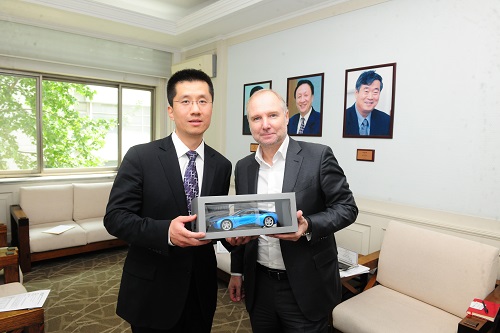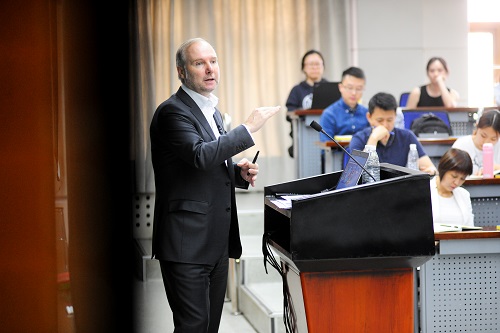Mr. Jochen Goller, President and CEO of the BMW Group
Marketing in digital era is a common challenge for practitioners in China, considering its fast evolving consumer perspective. For ambitious international brands committed to China market, consumer centrality drives the business success and needs to be analyzed thoroughly and implemented in bold action, with regard to digital acceptance, touch points, and new lifestyle of China’s rising youth. BMW, a premium carmaker with embedded innovation gene, is keen to ride the tide of auto industry transformation globally and in China. Mr. Jochen Goller, the President & CEO of BMW Group Region China, would like to share his experiences and established business cases on how BMW considers industry transformation, formulates the strategy of future mobility, and builds a young brand image with China’s unique technological enablers.

Professor Xu xin, associate Dean met with Mr.Jochen Goller, President and CEO of BMW Group Region China
During his visit to Tsinghua University’s School of Economics and Management, Mr Jochen Goller, President and CEO of BMW Group Region China, delivered an exclusive insight into BMW’s Chinese endeavor, covering industry transformation, future mobility, and marketing in the digital era.
Goller’s first stint for BMW in China was a vastly different venture to now. At that time, thirteen years ago, BMW employed 2,000 people and sold 2,000 cars per year. Now BMW employees 20,000 people and last year sold 560,000 cars. Thirteen years ago people questioned his choice of location; for BMW, China wasn’t in the top 20 markets. Now China is the number one market; larger than the second and third markets combined. Their footprints grown enormously since that first stint, it’s now comprised of two vehicle plants, one engine plant, a high voltage battery assembly factory, three development sites, five regional offices and 600+ sales outlets; it’s a huge enterprise. And that’s not all, there R&D footprint has grown and is doubling in size every two to three years; before it was designed in China for China, now it’s designed in China for the rest of the world.

Mr.Jochen Goller, President and CEO of BMW Group Region China
The School of Economics and Management played a role in the cementing of China in the heart of BMW. After the 19th Communist Party of China (CPC) National Congress President Xi Jinping met with members of Tsinghua SEM Advisory Board, including Harald Krüger, Chairman of the Board of Management, BMW AG. Krüger was deeply impressed by President Xi’s clear agenda and the meeting greatly helped BMW’s understanding of China’s strategic vision; it’s made Goller’s life easier!
A key outcome of the meeting is BMW’s belief that China will be the first market to really go electric. BMW challenge is that they’re a car company that has to move into technology. The new players’ challenge is that they’re technology companies that have to become car companies, which is also not an easy challenge as Tesla is finding. Goller acknowledged that it’s a race that will take some prisoners, however he thought that BMW is well placed in this race due to its experience in producing electric cars – they’ve been selling electric cars for the last 7 years – and due to its foundations in the China market.
Having covered the how important China is in BMW future, Goller moved onto how they’ve had to adapt to the Chinese market. For example, their Chinese customers are much younger than in Europe, on average around 20 years younger, and many of their customers are first time buyers. So they’ve adapted, using digital centric marketing to capture this digital native audience.
Goller talked through examples of how they’ve done this. From e-games, to music videos, to celebrity designed cars, to creating content on WeChat moments, they’ve had extraordinary success with their campaigns and the younger generation has responded very positively to their efforts. Goller believes that there’s a huge opportunity to execute high quality work with a creative user base. To execute there are crucial must-win battles: gain in-depth customer insight ‘know your customers’, activate the right digital touch point – ‘spend big but wisely’, and finally, be bold on content – ‘yet interactive and relevant’.